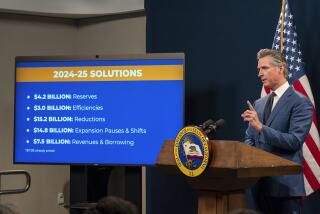Smoking Costs State’s Taxpayers Billions a Year, Report Indicates
Tobacco smoking costs Californians more than $7 billion annually in lost productivity and medical expenses, much of it borne by nonsmoking taxpayers, according to a new state study released Wednesday amid controversy over the tobacco tax initiative.
The state Department of Health Services study, based on statewide data and federal calculations of the health effects of smoking, was made public in spite of Gov. George Deukmejian’s announcement last week that he opposes the initiative, Proposition 99.
Following Deukmejian’s announcement, the department quietly suspended plans for press conferences in three cities. But after inquiries from reporters tipped off to the smoking study, the department hastily rescheduled a single “press availability” session.
“Hopefully, if folks aren’t interested in the fact that we have over 31,000 people a year dying . . . they at least will be interested in the fact that it’s costing a lot of money,” Dr. Kenneth Kizer, the department director, said at the event Wednesday in Burbank.
The study, described as the first of its kind, reached the following conclusions:
- Sixteen percent of all adult deaths in California in 1985--or 31,000 deaths--were attributable to smoking. Thirty percent of those were traced to lung cancer, 22% to heart disease and 24% to other respiratory diseases.
- Fourteen percent of all hospitalizations, excluding pregnancies, among adults that year were traceable to smoking. Those included 20,000 hospitalizations for lung cancer, 39,000 for smoking-related heart disease and more than 140,000 for other smoking-related respiratory diseases.
- Those hospitalizations and other medical expenses attributed to smoking cost Californians $4.1 billion in 1985. Seventy-seven percent of the $2.3 billion in hospital care costs were covered by taxpayer-supported programs such as Medi-Cal and Medicare.
- The total economic burden of smoking to Californians was more than $7.1 billion. In addition to the $4.1 billion in medical costs were $800 million in lost productivity due to illness and disability and $2.2 billion in lost future earnings from premature death.
“We think that they are hard, sound figures and they are very meaningful in translating to the public the staggering impact of smoking on the health and on the pocketbook of the taxpayers of California,” Kizer said.
Kizer insisted that there was nothing political in the study’s release.
‘Not Here to Advocate’
“I’m not here to advocate for or against Proposition 99,” he said. “Obviously the governor is my boss, and we all have bosses, and we all know that it’s probably not worthwhile to take positions contrary to your boss.
“I think, though, that part of my responsibility as the director of health . . . is to make this information available to (the public). . . . I do think that this is information that is relevant to individual decision-making as (voters) do look at their ballot.”
If approved in Tuesday’s election, Proposition 99 would raise the cigarette tax by 25 cents a pack. The money would be used to pay for health care for uninsured indigents, anti-smoking education, research into tobacco-related diseases and parks improvement.
In response to a question, Kizer said Deukmejian had not been shown the study before deciding to oppose the tobacco tax. Kizer said he had been told that the position of the governor, a nonsmoker, reflected not his views on tobacco but “his very strong views on taxes.”
The California study, which Kizer said is the first of its kind in the country, was funded in July, 1987, by a grant from the federal Centers for Disease Control. The grant, one of only three nationwide, was to be used to analyze state health data for patterns of chronic disease.
A task force convened to advise the department on the project chose smoking-related diseases as the top priority, Kizer said. He said the study employed “standard and accepted methodologies” and the most recent available statewide data, from 1985.
George Kaplan, the health department official who headed the study, said the cost estimates were surprisingly high. The study, he said, is based on hospital discharge and mortality data that was analyzed using official federal estimates of what fractions of specific diseases are caused by smoking.
“We’re hoping that it will help to galvanize interest in prevention programs and smoking cessation and also to bring some increased attention to the devastating toll from chronic diseases in California,” Kaplan said in an interview.
State health officials estimate that 22% to 24% of all Californians smoke--slightly below the national average of about 30%. California was the first state to see lung cancer become the leading cause of cancer deaths among women, reflecting the shift in smoking demographics.
Unfair to Nonsmokers
“The tobacco companies have said that a tax is unfair, that it taxes only smokers,” Dr. Lowell Irwin, head of the California branch of the American Cancer Society, said at the press briefing Wednesday. “We say that for many years it has been unfair that the nonsmokers have had to subsidize the smokers relative to these increased costs for medical care.” The Cancer Society had previously estimated costs to the state at $6 billion, according to Irwin.
More to Read
Get the L.A. Times Politics newsletter
Deeply reported insights into legislation, politics and policy from Sacramento, Washington and beyond. In your inbox three times per week.
You may occasionally receive promotional content from the Los Angeles Times.










